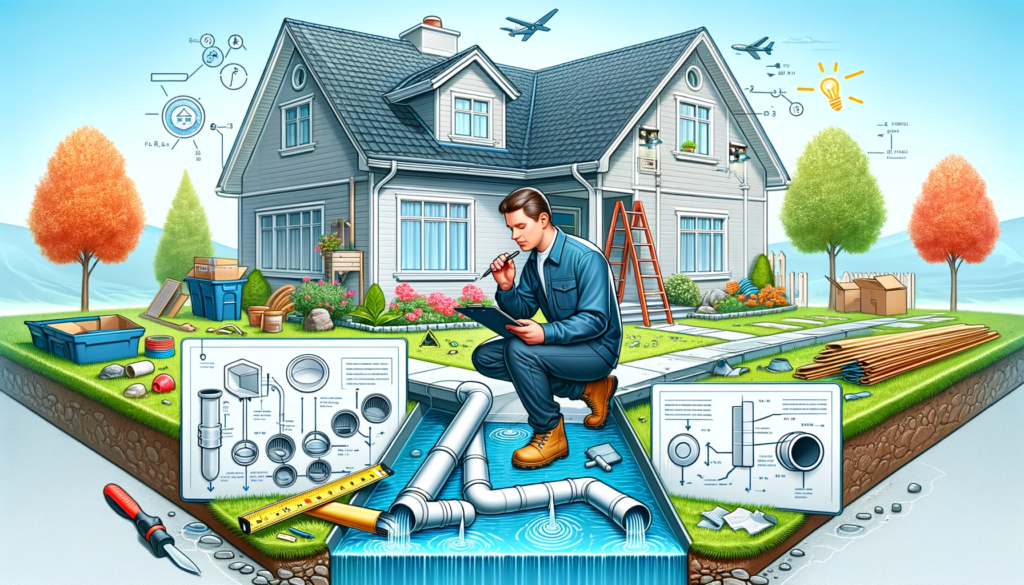Optimizing Your Home’s Water Flow: How to Conduct a Home Drainage Audit

Safeguarding your home from water damage begins with a thorough understanding and assessment of your home’s drainage. As we examine the intricacies of conducting a home drainage audit, we’ll present a detailed analysis complete with links for further reading, tables to simplify complex information, and lists to ensure no detail is overlooked. Let’s dive in and learn how to proactively protect our home from the myriad issues that poor drainage can precipitate.
Understanding Your Drainage System
The Basics of Home Drainage
Before we start turning over stones and inspecting gutters, it’s paramount that we have a foundational knowledge of our drainage system. A visit to Understanding Residential Drains will prime you on the essentials.
Diverse Drainage Types to Recognize
Surface Drainage handles the water pooling on ground levels, steering it clear from your property. Sub-Surface Drainage caters to excess water that saturates the soil, ensuring the land’s integrity. Gutters and Downspouts, meanwhile, play their part by catching roof water and funneling it well away from foundation walls. And not to be underestimated, Slope and Grading use gravity’s pull to guide water on its correct path away from our homes.
For an in-depth look at the array of systems at work, explore the comprehensive guide at Types of Home Drainage Systems.
| Drainage Type | Purpose | Key Component |
|---|---|---|
| Surface Drainage | Redirect surface water | Grates, Channels |
| Sub-Surface | Manage soil moisture | Drain Tiles, Pipes |
| Gutters/Downspouts | Roof water management | Troughs, Spouts |
| Slope/Grading | Natural water direction | Land Elevation and Contour |
Step 1: Gutter and Downspout Inspection
Kick off With Elevated Water Routes
First up, we cast an eye upwards to our gutters and downspouts, vital conduits that prevent water from making itself at home right where we don’t want it—against our home’s foundation.
Checklist for a Flawless Gutter System
- [ ] Debris-free and flowing channels
- [ ] Secure fastenings to the eaves
- [ ] Downspout extenders directing water away
Here’s a detailed breakdown of each step to ensure you’re well equipped for this task: Gutter Downspout Tips.
A More Detailed Look at Gutters and Downspouts:
| Action Item | Purpose |
|---|---|
| Clearing Leaves and Debris | Ensures unobstructed water flow |
| Inspecting for Rust or Damage | Prevents leaks and failures |
| Assessing Alignment/Installation | Verifies correct water diversion |
Step 2: Evaluate Landscape Slope and Overall Grading
Grasp the Gradient
The landscape’s slant is our next focus. It shouldn’t be underestimated because a perfect pitch can keep your foundation dry as a bone, while an imperceptible incline can invite water closer than desired.
Gradient Guidelines for Grading Greatness
- [ ] The ground should slope away at a minimum of 6 inches over a 10-foot run from the foundation.
- [ ] Look out for nearby hills and inclines that might influence water flow towards your home.
Lay eyes on the details here: Homeowners Drain Grading.
Measuring Your Yard’s Slope
Tools Needed:
- A level or a smart device with a leveling app
- A long, straight 2×4 or equivalent
- A measuring tape for vertical distance
Slope and Grading Concerns
| Issue | Potential Impact | Mitigation Tips |
|---|---|---|
| Insufficient Slope | Water pooling near home | Add soil to adjust elevation |
| Erosion | Slope degradation | Install retaining walls |
| Over-sloping | Runoff too rapid | Plant ground cover to slow flow |
Step 3: Investigate Drains and Surface Water Channels
Charting the Course of Water
It is essential that water on your property is given a clear pathway to follow, one that leads away from your home. This requires a keen eye for both the natural veins through which water tends to run and the man-made features designed to aid in this process.
Drainage Pathways and How to Appraise Them
Natural pathways could be simple depressions in the landscape, while artificial constructs could range from French drains to simple drainage ditches or complex systems featuring catch basins and underground pipes.
Assessment Process for Effective Water Flow
- [ ] Track where the water flows during rainfall.
- [ ] Perform a proactive inspection and cleaning of visible drains.
- [ ] Consider a gentle artificial rainfall (using a hose) to observe water’s movement in drier conditions.
For guidance on adding or improving your home’s drainage paths, see the DIY Drain Installation Guide.
Drain and Channel Evaluation Table
| Item | Status (Good/Fair/Poor/NA) | Notes/Actions Required |
|---|---|---|
| Natural Drainage Lines | ||
| French Drains & Swales | ||
| Stormwater Drains & Catch Basins | ||
| Grading and Land Contours |
Addressing Drainage Anomalies
When Problems Emerge
Even with the most meticulous examination, you might stumble upon issues within your drainage system. It’s vital to act swiftly and decisively.
Immediate and Long-Term Responses to Drainage Concerns
Immediate actions involve removing blockages, adjusting downspouts or redirecting runoff. Long-term strategies include routine cleaning, strategic landscaping, and possibly installing additional drainage infrastructure.
Tactics to Tackle Troublesome Drainage
| Problem | Immediate Solution | Long-Term Strategy |
|---|---|---|
| Clogged Gutters | Clean and repair | Install gutter guards |
| Inadequate Slope | Re-grade area | Consult with a landscaper |
| Poor Drainage | Install additional drains | Plan a full drainage project |
For broader insights into how homeowners might approach improving their homes’ water channeling, check out Improving Home Drainage.
Step 4: The Telltale Signs in Your Basement and Foundation
Investigating the Interior Indicators of Drainage Issues
Once the external checks are complete, turn your attention to the basement and foundation—these areas often reveal the most about your home’s drainage efficacy. Moisture marks or efflorescence on walls, musty odors, and visible cracks can all signal the need for immediate action.
Signs to Watch For
- [ ] Water Stains: Mark where water has intruded.
- [ ] Mold Growth: Speaks to persistent dampness.
- [ ] Foundation Cracks: Could result from water pressure.
If you’ve discovered signs of moisture, take a look at Basement Drainage Solutions for expert advice.
Basement and Foundation Health Table
| Area Examined | Problem Identified | Severity (Minor/Major) | Recommended Action |
|---|---|---|---|
| Basement Walls | |||
| Basement Flooring | |||
| Foundation Exterior |
Taking Action When Problems Are Identified
Responsive Measures for Drainage Dilemmas
Upon spotting drainage irregularities during your audit, prioritize swift intervention to mitigate the risk of water damage. Simple DIY fixes can sometimes bridge the gap until professional help can be enlisted for more significant concerns.
Strategic Actions for Common Drainage Flaws
- Unblock and repair affected areas immediately.
- Re-slope your yard if the audit suggests improper grading.
- Engage a specialist for substantial and intricate issues, ensuring you refer to our guide on Choosing a Drainage Contractor.
Practical Problem-Solving Tactics
| Drainage Issue | DIY Fix | Professional Fix |
|---|---|---|
| Blocked Drains | Use a plumbing snake or chemical cleaner | Seek pipe repair/replacement services |
| Poorly Directed Downspouts | Extend spouts further from the house | Install underground drainage systems |
| Inadequate Yard Grading | Add topsoil to increase slope | Landscape redesign for water management |
Final Thoughts and Further Resources
Seal the Deal: The Importance of Drainage System Upkeep
Consistently tending to your drainage system not only extends the lifespan of your investment in your property but also guarantees you peace of mind. By embracing vigilance and preventive maintenance, you can ward off the majority of water-related nuisances.
Ongoing Maintenance for Drainage Excellence
- Regular cleaning of gutters and inspection of sub-surface drains.
- Monitoring the landscape for new developments affecting water flow.
- Upgrading landscaping for superior water management, as expounded upon in Landscaping and Drainage.
Drainage Audit Follow-Up Checklist
- [ ] Perform gutter cleanup after the fall and spring.
- [ ] Revisit drainage pathways after major storms.
- [ ] Schedule annual professional inspections for sub-surface systems.
Consider exploring our wealth of knowledge on drainage care, including Drain Maintenance Tips and Seasonal Drainage Care, to ensure your home remains a safe, dry sanctuary throughout the changing seasons.
Your proactivity with home drainage audits can remarkably diminish the likelihood of incurring water damage, thereby elongating the durable life of your property. Keep abreast of the latest Innovative Drainage Products that can bolster your efforts in maintaining a dry and healthy home.
Key Takeaways for Conducting a Home Drainage Audit
| Key Aspect | Takeaway Point |
|---|---|
| Understanding Drainage | Familiarize with the types of drainage systems and assess their current state. |
| Gutter & Downspout Audit | Regular checks & cleaning can prevent foundational water damage. |
| Landscape Grading | Proper slope and grading are critical for effective drainage. |
| Drains & Water Pathways | Ensure all drainage features are functional and clear of obstructions. |
| Basement & Foundation | Internal moisture, mold, and cracks indicate potential drainage concerns. |
| Action Steps | Address issues quickly with DIY fixes or contact professionals for serious problems. |
| Ongoing Maintenance | Consistent upkeep and seasonal maintenance play crucial roles in avoiding water damage. |
| Professional Assistance | For complex issues, consult guides on choosing the right contractor for specialized help. |
| Resource Utilization | Utilize available resources, like DrainFixPros articles, to guide and enhance your drainage audits. |




